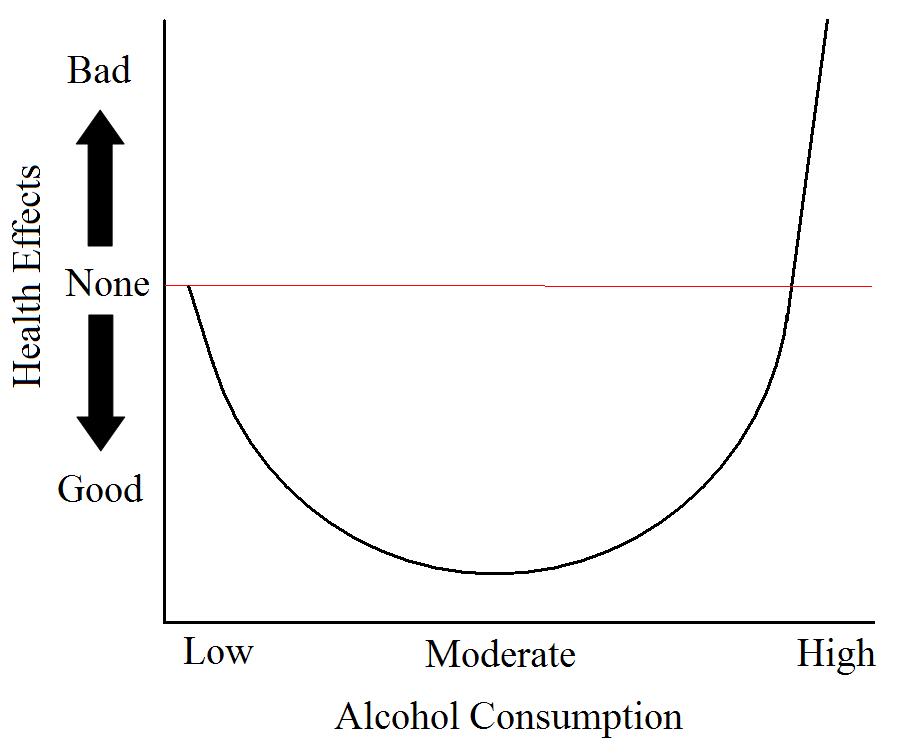 lcohol consumption is often demonised for its negative effects. However, the nutritional sciences show alcohol consumption to fit a ‘J’-shaped curve with regard heath. At low intakes, alcohol has no effects positive or negative. However, as alcohol consumption rises, beneficial effects occur. Only as alcohol consumption rises further do the negative effects of alcohol manifest as metabolic abnormalities detrimental to long-term health (figure 1). It has been hypothesised that alcohol is beneficial because certain drinks are known to contain high concentrations of antioxidants. For example, cider and wine both contain antioxidants present in apples and grapes, respectively. However, studies show that alcohol has beneficial properties on the body, irrespective of the presence of additional substances in the drink (here). The mechanism by which alcohol has beneficial effects is not known but may relate to the ability of ethanol to improve the fluidity of membranes because of its lipid solubilising effects.
lcohol consumption is often demonised for its negative effects. However, the nutritional sciences show alcohol consumption to fit a ‘J’-shaped curve with regard heath. At low intakes, alcohol has no effects positive or negative. However, as alcohol consumption rises, beneficial effects occur. Only as alcohol consumption rises further do the negative effects of alcohol manifest as metabolic abnormalities detrimental to long-term health (figure 1). It has been hypothesised that alcohol is beneficial because certain drinks are known to contain high concentrations of antioxidants. For example, cider and wine both contain antioxidants present in apples and grapes, respectively. However, studies show that alcohol has beneficial properties on the body, irrespective of the presence of additional substances in the drink (here). The mechanism by which alcohol has beneficial effects is not known but may relate to the ability of ethanol to improve the fluidity of membranes because of its lipid solubilising effects.
 Figure 1. The ‘J’-shaped curve representing the effects of alcohol on the body. At low intakes, no effects are seen. As intakes rise to ‘moderate’, beneficial effect manifest. At high intakes, negative health effects are likely, including damage to the liver. This can lead to metabolic abnormalities such as Wernicke-Korsakoff syndrome, the result of an alcohol induced thiamine deficiency.
Figure 1. The ‘J’-shaped curve representing the effects of alcohol on the body. At low intakes, no effects are seen. As intakes rise to ‘moderate’, beneficial effect manifest. At high intakes, negative health effects are likely, including damage to the liver. This can lead to metabolic abnormalities such as Wernicke-Korsakoff syndrome, the result of an alcohol induced thiamine deficiency.
Although most of the research to date has focused on the effects of alcohol on cardiovascular health, other beneficial effect have been reported. One way in which moderate alcohol consumption may benefit women is through an improvement in bone mineral density. For example, one group of researchers1 investigated the association between bone mineral density and alcohol consumption in a cross-sectional study of 3218 women aged 50-62 years. Women who consumed more than 1 alcoholic drink per day had significantly greater femoral neck bone mineral density than those who never consumed alcohol, irrespective of other lifestyle choices. Those who drank beer had an increase in lumbar spine bone mineral density following lifestyle adjustments. Interestingly, there was a trend for increasing bone mineral density with increasing alcohol consumption. However, the higher intakes of alcohol consumption had so few women within the groups that statistical significance was lost.
In another study2, researchers investigated the association between bone mineral density and alcohol intake in 489 elderly women aged 65-77 years using baseline data from those enrolled on an osteoporosis study. From this data the researchers reported that women who consumed alcohol had a 10 % increase in spinal, 4.5 % increase in total body, and a 6 % increase in midradius bone mineral density, when compared to those not consuming alcohol. Consuming alcohol at over 28.6 g per week (equivalent to around 2.9 units or 2 to 3 glasses of wine) was associated with an increase in bone mineral density. However, maximum beneficial effects of alcohol were seen at between 28.6 and 57.2 g per week. At this concentration there was a 16 % increase in spinal, a 12 % increase in total body and a 14 % increase in midradius bone mineral density, compared to those not consuming alcohol regularly.
These results suggest that moderate alcohol consumption is associated with improvements in bone mineral density, and may therefore be beneficial in reducing the risk of osteoporosis and fractures. Interestingly, alcohol consumption is associated with a reduction in serum osteocalcin and the ratio of urinary cross-linked N-telopeptides of type I collagen to creatinine, suggesting that bone remodelling may decrease with alcohol consumption2. In addition, serum parathyroid hormone is significantly reduced in alcohol consumers compared to non-alcohol consumers, which may explain the reduction in bone resorption seen with moderate drinking2. Although these studies have focused on women due to their increased risk of developing osteoporosis, alcohol consumption has been shown to benefit the bone mineral densities of men. Studies that have shown positive effects for alcohol on bone mineral densities seem to show a pattern of increased lumbar spine densities, although the reason for this is not clear.
RdB
